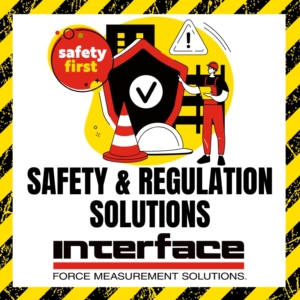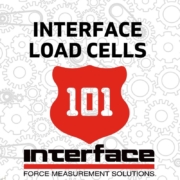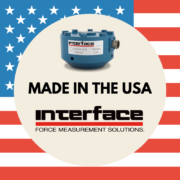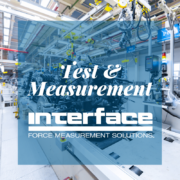Interface Solutions for Safety and Regulation Testing and Monitoring
 Among the many challenges we help to solve, safety and the stringent requirements for helping to make products safer for all types of users is top of the list. Interface’s solutions are known for quality and accuracy, which are at the forefront of all decisions used for safety and regulation testing. It is one of the top reasons consumer product makers choose Interface force, torque and weighing test and measurement solutions.
Among the many challenges we help to solve, safety and the stringent requirements for helping to make products safer for all types of users is top of the list. Interface’s solutions are known for quality and accuracy, which are at the forefront of all decisions used for safety and regulation testing. It is one of the top reasons consumer product makers choose Interface force, torque and weighing test and measurement solutions.
Everyone involved in the production and sale of products have a role to play in ensuring product safety and compliance with regulations, from the manufacturer to the retailer of any product. They are all responsible for designing, testing, and producing safe products.
Manufacturers have the primary responsibility for ensuring that products are safe and compliant with regulations. Governments have the authority to establish safety standards and regulations for products and to enforce these standards through inspections, fines, and recalls. Independent testing labs are used to conduct safety and compliance testing. These labs provide impartial and objective test results. Retailers also have a responsibility to ensure that the products they sell are safe and compliant with regulations. By working together, they can help to promote public trust in products and reduce the risk of accidents and injuries.
In engineering, the safety and regulation testing of products is crucial for ensuring that products are safe for use and meet industry standards. This type of testing helps to identify potential hazards and design flaws that could harm consumers or cause damage to property. It also ensures that products comply with regulations and standards set by governing bodies such as the Consumer Product Safety Commission (CPSC) and the International Electrotechnical Commission (IEC). This helps to protect consumers, promote public trust in products, and reduce the risk of liability for manufacturers. By performing safety and regulation testing, engineers can help to ensure that products are reliable, effective, and trustworthy.
Safety and regulation testing helps manufacturers in several ways:
- Liability reduction: By ensuring that products meet safety standards and regulations, manufacturers can reduce their risk of liability in the event of accidents or injuries caused by their products.
- Consumer trust: Consumers are more likely to trust and purchase products that have been tested and found to be safe and compliant with regulations.
- Marketability: Products that meet safety and regulation standards are more likely to be accepted in the market and sold to a wider range of customers.
- Brand reputation: A company’s reputation is closely tied to the safety and quality of its products. By demonstrating a commitment to safety and compliance, manufacturers can enhance their brand reputation and build consumer trust.
- Cost savings: Investing in safety and regulation testing can help manufacturers identify and correct design flaws before products are mass-produced, reducing the cost of recalls and liability claims.
We work with manufacturers of heavy machinery, vehicles, consumer goods, medical devices and pharmaceuticals, and even aircraft and rocket ship builders. All these industry experts know that precision test and measurement solutions are essential for eliminating the serious threat to humans when their inventions and products are not thoroughly tested and monitored properly.
Testing is the first step in the process of ensuring safety. Interface load cells and torque transducers are used to test a wide variety of parameters related to force. For instance, Interface provides solutions for projects involving the testing of cranes and ensuring that these massive machines are able to lift the weight that the particular product’s specifications allow. This ensures safety for the user and those on the ground by putting the machine through rigorous testing using load cells to measure the cranes maximum limits with various loading conditions. Watch a quick demonstration video of crane safety test solutions from Interface.
In addition, force measurement can be used to measure small and precise forces during the testing phase. One such example is the use of load cell load buttons to measure the clamping force of a vascular clamp used in surgery. This force needs to be tightly tuned in regulation with stringent medical requirements. Forces too small or large could have serious repercussions for the patient. This is a simple test that makes a dramatic difference in which the clamp force is applied to these miniature load cells and the force signal is sent to the tester.
One specific requirement that Interface has a great deal of experience in supplying solutions is for torque testing on lug nuts, bolts and other assembly equipment. While tightening these parts may seem like a simple process, industries like automotive and aerospace have strict requirements for the exact tightness and tolerance for bolts. We provide torque testing system devices that evaluate these parameters accurately to meet those regulations. Any misstep in tightening can lead to severe failure that puts the user at significant risk, not to mention pedestrians when it comes to the automotive industry.
The next use of force measurement in the realm of safety is by using sensors for real time monitoring. Load cells and torque transducers can be designed into a product to allow for monitoring of the product in use, telling the user when it needs to be repaired. They can help by notifying the user if a vehicle or machine is holding weight above its capacity, or if there is potential failure of a machine or product.
For instance, machines on a production line can be monitored and irregular data can show that it needs to be brought down briefly for repairs. Having machines with issues that are not noticed do not only affect efficiency, but it can also pose a threat to nearby workers. Additionally, monitoring something like a crane is also a way to ensure it is not overloaded.
These applications provide notable examples of how force measurement can guarantee meeting safety requirements and regulations, as well as monitoring for safe conditions in real time. To provide a visual example, we have developed several applications notes, a few of which we have included below.
Regulatory Medical Device Stent And Catheter Testing
A customer needed to apply known forces to stents and catheters to ensure they pass all necessary strength and flexibility testing. Interface suggested an MBP Overload Protected Beam Miniature Load Cell be placed behind the guide wire for the stent or catheter. The motor will spin the linear drive and push the load cell and guide the wire through the testing maze. The MBP Overload Protected Beam Miniature Load Cell is connected to the DIG-USB PC Interface Module. All forces are measured and stored on a computer. Using this solution, the customer was able to perform required testing and logged, followed by being able to review results and take actions as needed. Get more information about this testing in our Stent and Catheter Testing App Note.
Equipment Safety with Bolt Tension Monitoring
A customer wanted to monitor the tension of the bolts that are used on their industrial large metal pipes. Interface suggested installing multiple LWCF Clamping Force Load Cells, each connected to WTS-AM-1E Wireless Strain Bridge Transmitter Modules. The load cells were installed under the tightened bolts on the pipes and measured the compression forces from the bolts. The real-time results were transmitted wirelessly from the WTS-AM-1E’s to the WTS-BS-6 Wireless Telemetry Dongle Base Station when connected to the customer’s PC. Real-time results from the LWCF’s were displayed using provided Log100 Software. Interface’s load cell monitoring system successfully monitored the compression forces of the bolts in real time.
Public Safety Bridge Seismic Force Monitoring Solution
A customer wanted to monitor seismic activity that occurs to a bridge by using force sensors and then continuously monitor bridge forces before, during, and after earthquakes occur. The customer also preferred a wireless solution so they would not need to run long cables on the bridge. Using Interface’s LP Load Pin custom made to fit their needs, alongside the Interface WTS Wireless Telemetry System, continuous force monitoring was able to take place without long cables, allowing the customer to monitor continuous loads, log information to the cloud, and review information. Read Bridge Seismic Force Monitoring Solution App Note for more information.
If you are looking for accurate and dependable solutions to assist with testing and monitoring for safety and regulatory requirements, contact us.
ADDITIONAL RESOURCES
Crane Block Safety Animated Application Note
Load Cells for Consumer Product Applications
Interface Solutions for Production Line Engineers
CPG Bike Frame Fatigue Testing
MARITIME Crane Block Safety Check
Crane Safety Requires Precision Measurements Ship to Shore
Entertainment Venue Force Measurement and Monitoring Solutions








